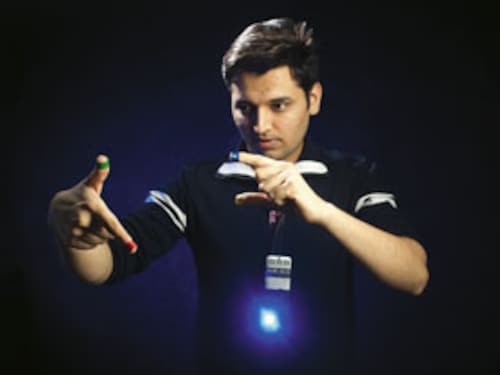Leonardo da Mistry
Pranav Mistry, the young innovator from MIT Media Lab has already won accolades. He now wants to be the new-age Renaissance Man


It’s funny,” says Pranav Mistry over the phone from Tokyo in that endearing Palanpuri accent — a reminder of his boyhood days in Gujarat. “Even when I talk crap now, people take me seriously.” And he does it often enough. Talk crap, that is. Partly to entertain himself partly to remind himself he ought to stay clear of the crap.
There was this time for instance a few years ago when he was a student at the Indian Institute of Technology (IIT), Mumbai. Every weekend, students at the design course he took were expected to showcase two one-minute films. The first, a clipping from any movie directed by their favourite filmmaker. The second, something the student created in an attempt to emulate the work of their hero. The exercise was followed by a critique of the student’s film by faculty members. A premium was placed on how good the student’s interpretation was.
When it was Mistry’s turn, he reversed the order in which the clips were showcased. He first displayed the clip he made and followed it up with that of the master director. Predictably enough, the second clip came in for heavy criticism because it did not adhere to the “master’s” vision articulated by the earlier clip. Everybody laughed their guts off at the “practical joke”. But Mistry didn’t intend it as one. It was only meant to test a theory he deeply believed in: Any original idea will come in for punishment because people cannot comprehend it. Everybody needs a frame of reference to hang on to, however mediocre it is.
Which is why, when he moved to the prestigious Media Labs at MIT, it was easy to shrug off the initial scepticism his experiments attracted. Mistry’s premise there was an interesting one. He thought of himself as a “very physical guy” who liked his cricket, football, clay modelling and interactions with people. After he got into engineering school though, “life got boring,” he says.
The whole emphasis, he explains, was on migrating from a physical world into a digital world. “I don’t like it and I want my physical world back,” he says. So Mistry proposed an idea that is the exact opposite of everything else the world is working on. Instead of us migrating into the digital world, why don’t we import the digital world into our physical lives? This was the genesis of Sixth Sense, a device that has now attracted attention from the finest minds in the world and has won for Mistry practically every major popular science award that there was to be won in 2009.
What the device (built by combining a miniature projector, webcam and a notebook computer) is capable of, is straight out of the future. You want to know the time? Just use your fingers to draw an imaginary watch on the wrist and the time is projected there. Like something and want a picture taken? Use your fingers to frame the picture you want, and the job is done. In a meeting and need background information? A few gestures and the device can pull it off the Internet and project it on your table. Reading a newspaper? The device scans Web sites while you’re at it and projects related videos onto the pages. Need to place a call? The device generates a keypad on your palm to dial and talk. The possibilities are limited only by your imagination.
“It’s the kind of thing that can turn the world of consumer electronics upside down,” says Vinay Gidwaney, Mistry’s contemporary at MIT and an entrepreneur. “I don’t know,” says Mistry. “I just do things to make people’s lives easier.”
And as if to prove the point, soon after he demonstrated the technology, he announced it would be Open Source. Which means anybody can look into its innards and take it any which way they want to.
“What next Pranav?” I ask him.
“I don’t know,” he says. “I want to be like Leonardo da Vinci. What do you call him, scientist, artist, sculptor, mathematician? He was all of that. I don’t want to be remembered for only this. I’ve got a lot many crazier ideas. And someday, I’d like to act in a movie. I want to enjoy life in all its colours. I want to live like I’m going to die tomorrow, and learn like I’m going to live forever.”
First Published: Dec 31, 2009, 08:49
Subscribe Now(This story appears in the Jun 12, 2015 issue of Forbes India. To visit our Archives, Click here.)